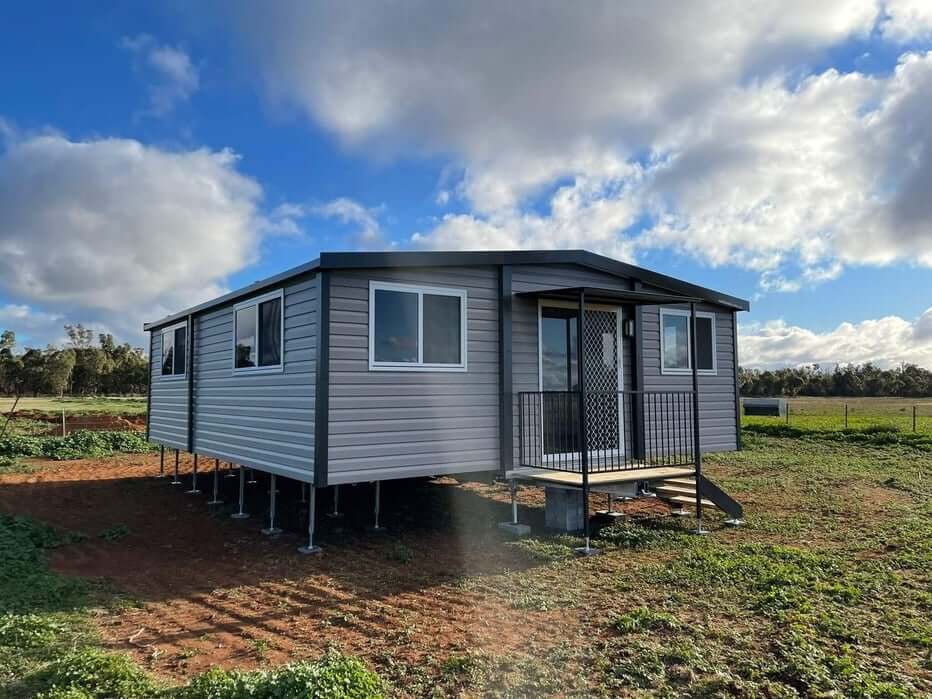
Many caravans can become unstable in heavy winds. A strong gust can result in the caravan overturning and damaging anything inside. In comparison, our VanHomes have been designed, built, and tested for the Australian climate, including strong winds.
Because VanHomes are 100% relocatable, they don’t have a wind rating. However, we take every step to ensure your VanHome will be as safe from strong winds as possible.
While we build VanHomes to be relocatable and easily folded out, we understand how important it is to protect against the weather. This article will cover how we've designed our VanHomes to protect against strong winds. Then we'll demonstrate two ways you can help further protect your VanHome.
Roof Design
We build our VanHomes with strong, Structural Insulated panels that allow wind to pass over them more easily than other materials. Most of the time, when a roof is hit with a force of the wind, it's an uplifting force. If your roof has more than a 30-degree pitch, it's more likely to allow the wind to catch it and cause damage. VanHomes have only a 7-degree pitch, allowing the wind current to pass over it without any issue.
Tie-Down Points
Every VanHome is manufactured with tie-down points around the perimeter of the VanHome. This means that if your area is prone to extreme winds, you can tie your VanHome down. We weld these tie-down points onto the frames and chassis, so our VanHomes have no problem handling dangerous winds.
Some of our customers tie down their VanHomes in cyclonic areas such as Far North Queensland and have successfully survived strong winds with no issue to their VanHome.
It is essential to take all precautions, though, to ensure your VanHome is secure. As we are a transportable home, there is the need for more significant consideration for securing your asset.
Durable Materials
We manufacture our VanHomes in our Somersby headquarters, so we understand how brutal Australian conditions can be. The trailers and walls of our VanHomes are built with a mixture of high-grade aluminium and steel. Unlike other weatherboard products, our cladding is a vinyl material that's been guaranteed not to rot, dent, split, crack, or peel. We build our windows with residential grade glass. Finally, we use hard-wearing, water-resistant Form ply for our flooring.
Low COG
We've designed our VanHomes to have a low centre of gravity (COG). This helps to minimise toppling or tipping in extreme weather. We use 3mm steel for our chassis, making us heavier than the average caravan. However, this added weight comes with added durability.
How Else Can I Protect my VanHome From Strong Winds?
There are two primary ways to protect your VanHome from strong winds: tying it down and covering the bottom of its high wind areas.
How to Tie Down Your VanHome
There are a couple of different ways that you can secure your VanHome.
Peg Option: You'll need pegs 2/ 40 x 40 x 3 EA 1.5m in length stitch welded with two barbs, such as Star Pickets. Each peg should be attached to one of the provided chassis tie-down points with an 8mm high-tensile chain and matching shackles.
The pegs should have a minimum embedment of 1400mm into undisturbed earth. The pegs should be angled to the vertical 20-degrees away from the van and driven into position. Ideally, this should be done by a jackhammer.
Ground Anchors are the ideal type of peg to pick up in Australia, acting as a cheaper, easier to manufacture option with higher anchoring capabilities. You can learn more about Ground Anchors here.
Concrete Block Option: You'll need concrete blocks with a minimum size of 600 x 600 x 600 (0.22 cubic meters). These blocks should be positioned along the centre line of the van. You should either cast them into the earth or use them as pre-cast ballast weights placed on the ground.
Each block can then be attached to the chassis tie-down points with an 8mm high tensile chain and matching shackles.
How to Minimise Uplift of Your VanHomes High Wind Areas
As VanHomes are raised off the ground, you may want to avoid having the bottom section open to the wind. If you leave this section uncovered, it has the potential to catch the wind underneath, causing lifting.
Sheet metal, such as corrugated Colorbond, can help close the bottom of your VanHome. This will block any wind from accessing underneath the unit.
Our dedicated team works to create specialised solutions for your housing requirements.
Using innovative designs and materials combined with quality craftsmanship, VanHomes is on the path to being Australia's preferred choice as a supplier of portable housing.
VanHomes is unique by nature. As a registrable caravan, your VanHome can be easily added as a second dwelling without the need for council or building approvals for most properties.
.jpeg?width=512&name=unnamed%20(1).jpeg)
